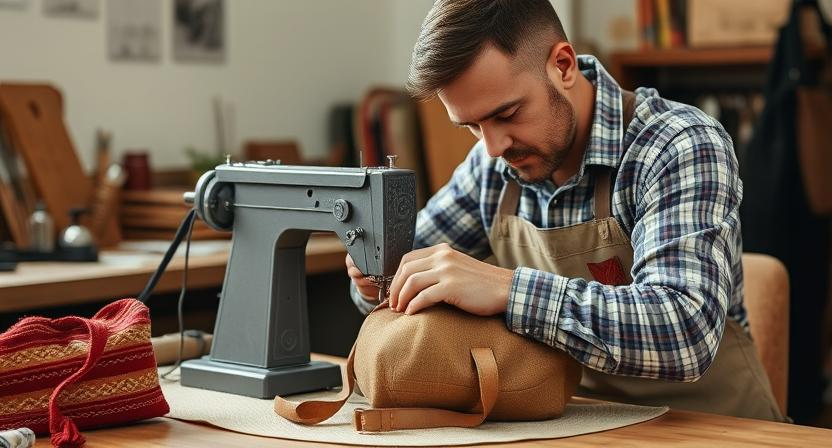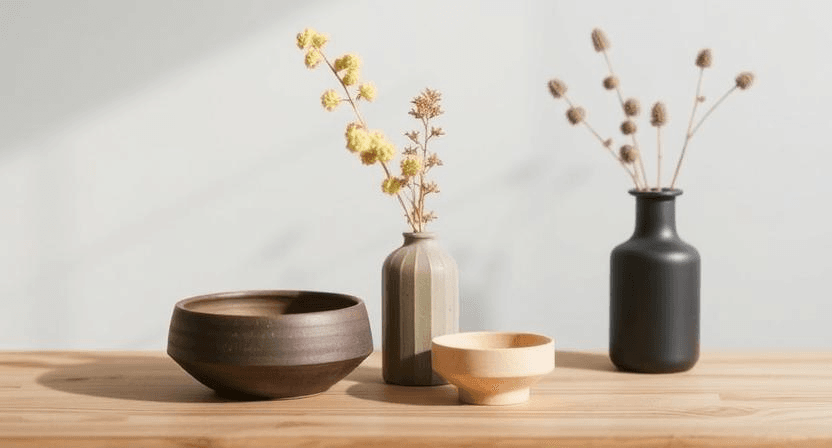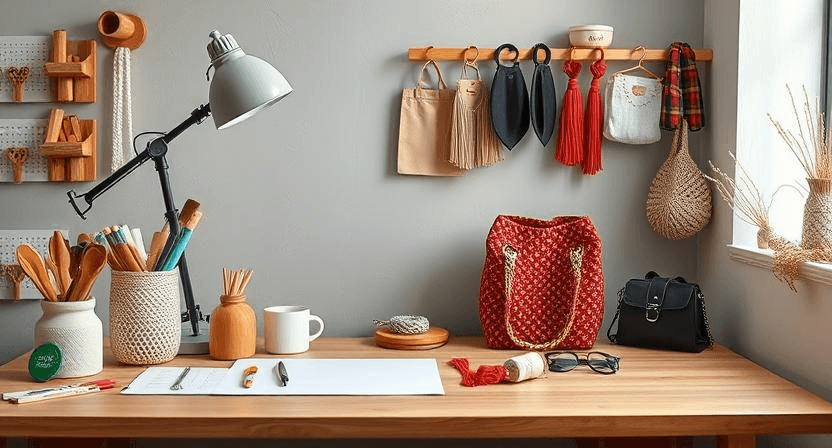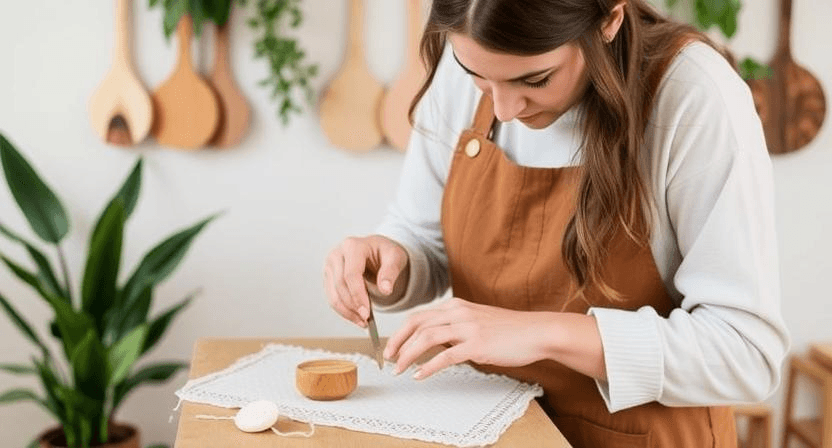Your cart is currently empty!
Category: Trends & Inspiration
Stay ahead of the curve with the latest trends and creative inspirations in the world of handmade crafts. From eco-friendly designs to personalized gifts, our Trends & Inspiration section is your go-to resource for discovering what’s hot in the crafting world. Whether you’re looking for fresh ideas for your next DIY project or seeking inspiration to incorporate into your handmade products, this category will keep you inspired and informed.

The Benefits of Choosing Handmade Over Mass-Produced: A Craft Lover’s Perspective
In today’s fast-paced consumer culture, it’s easy to reach for cheap, mass-produced items. But for craft lovers, handmade goods offer something deeper—something personal, meaningful, and lasting. Whether it’s a handcrafted bag, a hand-embroidered pouch, or a DIY accessory, the difference goes far beyond appearances.
1. Unique and One-of-a-Kind
Mass-produced items are designed for uniformity. Handmade crafts, on the other hand, are shaped by the hands, time, and care of an individual. Every stitch, brushstroke, or knot reflects a creative decision. This uniqueness means that no two handmade items are ever exactly alike—a rare quality in a world of mass replication.
2. Quality Over Quantity
Crafters take pride in their work. Unlike factory-made products that often prioritize speed and cost-cutting, handmade goods are built with attention to detail. This translates to better materials, stronger construction, and a longer lifespan. Handmade isn’t just beautiful—it’s reliable.
3. Sustainability and Ethics
Mass production often comes at a high environmental and ethical cost—think of factories, waste, and unfair labor. Handmade products typically use fewer resources and support local artisans or small businesses. When you choose handmade, you’re often choosing sustainable materials, ethical practices, and a slower, more intentional form of consumption.
4. Emotional Connection
When you make something by hand or purchase from a creator, there’s a story behind the product. That story adds value. Whether it’s a gift or a personal keepsake, handmade crafts hold meaning and emotion—something mass-produced items can never replicate.
5. Supporting Real People and Passion
Behind every handmade item is a real person—someone who spent hours honing their skills and creating something with love. Supporting handmade means supporting passion, creativity, and small communities of makers who are keeping traditional crafts alive.
Final Thoughts
Handmade goods may not be the fastest or cheapest option, but they offer authenticity in a world increasingly driven by convenience. As craft lovers, choosing handmade is not just a preference—it’s a statement of values. A love for art, sustainability, and meaningful connection.
So the next time you’re choosing between a machine-made bag and a handcrafted one, think of the heart, history, and hands behind the craft.

The Rise of Minimalist Handcrafted Goods: Simple, Sustainable, and Stylish
In recent years, the world of craftsmanship has experienced a remarkable shift, with minimalist handcrafted goods becoming a dominant trend. Consumers are increasingly drawn to simple, sustainable, and stylish products that not only reflect personal style but also contribute to a more eco-conscious lifestyle. This shift toward minimalism is more than just a design preference—it’s a movement that speaks to the values of sustainability, mindfulness, and a desire for timeless, functional beauty.
1. What is Minimalist Crafting?
Minimalist crafting focuses on the concept of “less is more.” It emphasizes clean lines, subtle aesthetics, and functionality over excessive ornamentation. In a world overloaded with mass-produced, disposable items, minimalist handcrafted goods offer a refreshing alternative. These pieces are often made with high-quality materials, showcasing the artisans’ skill and creativity, while keeping designs simple yet elegant.
2. The Appeal of Simplicity and Sustainability
As people become more aware of the environmental impact of their consumption habits, there’s a growing desire for products that are not only beautiful but also sustainable. Minimalist handcrafted goods fit perfectly into this trend. Made from natural, eco-friendly materials such as wood, clay, metal, and sustainable fabrics, these products are designed to last for years, reducing the need for constant replacement. The simplicity of these items means they don’t go out of style, making them timeless additions to any home or wardrobe.
3. The Environmental Impact of Minimalist Crafting
One of the biggest draws of minimalist handcrafted goods is their reduced environmental impact. Many of these goods are made by small, local artisans who use sustainable production methods, ensuring that the crafting process has a minimal carbon footprint. Additionally, the materials used are often renewable, recyclable, or biodegradable, contributing to a circular economy. This approach contrasts sharply with fast fashion and mass production, where overproduction and waste are major concerns.
4. How Minimalist Crafting Is Shaping the Handmade Goods Industry
The rise of minimalism has disrupted traditional crafting markets. Artisans are shifting away from overly elaborate designs, focusing instead on simplicity, quality, and practicality. Consumers are increasingly looking for items that align with their values of sustainability and slow living. Whether it’s a handwoven blanket, a minimalist wooden chair, or a simple leather wallet, minimalist handcrafted goods offer an authenticity and durability that mass-produced items cannot.
5. How to Incorporate Minimalist Handcrafted Goods into Your Life
Incorporating minimalist handcrafted goods into your lifestyle doesn’t have to be difficult. Start by choosing items that align with your personal taste and values. Opt for versatile, high-quality pieces that can serve multiple functions. For example, a minimalist wooden tray can be used in the kitchen, on your desk, or as a decorative piece. A handcrafted leather bag can be both a stylish accessory and a functional everyday item.
6. Supporting Local Artisans and the Handmade Movement
By choosing minimalist handcrafted goods, consumers are also supporting local artisans and small businesses. These artisans take pride in their work, often using age-old techniques passed down through generations. Purchasing from them not only ensures the creation of unique, high-quality items but also helps preserve traditional crafts and supports a more sustainable economy.
7. The Timelessness of Minimalist Designs
What makes minimalist handcrafted goods so attractive is their timelessness. Unlike trendy items that quickly fall out of style, minimalist designs remain relevant across seasons and years. This timeless quality makes them excellent investments, as they will continue to add value to your life long after they’ve been purchased. A minimalist wooden chair, for example, may serve as a statement piece in your home for decades to come.
Conclusion:
The rise of minimalist handcrafted goods is more than just a passing trend. It’s a reflection of our growing desire for simplicity, sustainability, and timeless beauty. By embracing minimalist crafting, we not only enhance our lives with elegant, functional items but also contribute to a more sustainable and mindful future. Whether you’re purchasing a handcrafted piece for its aesthetic value or its environmental benefits, minimalist craftsmanship represents a conscious shift toward a more sustainable and thoughtful way of living.

Sustainable Crafting: How Eco-Friendly Trends are Shaping Handmade Goods in 2025
As sustainability continues to be at the forefront of global conversations, it’s no surprise that eco-friendly trends are making a significant impact on the world of handmade crafts. In 2025, more crafters and artisans are turning to sustainable materials and practices to reduce their environmental footprint while creating beautiful, unique pieces. In this blog post, we explore the top eco-friendly crafting trends for 2025 and how they are transforming handmade goods across various industries.
1. The Rise of Natural and Recycled Materials
In 2025, natural and recycled materials will continue to be the cornerstone of eco-friendly crafting. Crafters are increasingly opting for organic fibers like hemp, linen, and organic cotton, which are not only better for the environment but also add a touch of authenticity and texture to handmade goods. Additionally, recycled materials like paper, glass, and plastic are being creatively repurposed to create stunning products that tell a story of sustainability.
Inspiration: Start incorporating recycled fabrics into your sewing projects or experiment with natural fibers in knitting or crocheting. The beauty of these materials lies in their eco-friendly nature and timeless appeal.
2. Zero-Waste Crafting
Zero-waste crafting is gaining momentum as more people embrace the philosophy of reducing, reusing, and recycling. In 2025, this trend will evolve further, with artisans finding innovative ways to repurpose leftover materials and reduce waste during the crafting process. Whether it’s turning fabric scraps into patchwork quilts or using excess yarn for smaller projects, zero-waste crafting allows crafters to minimize their environmental impact while making the most out of their materials.
Inspiration: Try making small accessories like keychains or bookmarks from fabric scraps or old clothing. These projects are not only eco-friendly but also allow you to create something useful out of leftover materials.
3. Eco-Friendly Paints & Dyes
As more crafters seek to reduce their environmental impact, eco-friendly paints and dyes are becoming increasingly popular. Natural dyes made from plants, fruits, and vegetables are gaining traction, as they are non-toxic and biodegradable. Furthermore, eco-friendly paints, such as water-based and low-VOC paints, are being used in everything from home décor to pottery. These products provide vibrant colors without compromising the planet.
Inspiration: Experiment with natural dyes to color your fabrics, yarn, or even paper. You can create beautiful, earthy tones using materials like turmeric, berries, or coffee grounds.
4. Sustainable Packaging
In 2025, sustainable packaging will become a key focus for crafters who sell their handmade goods. Instead of using plastic or other harmful materials, many artisans are turning to biodegradable, recyclable, or reusable packaging options. Eco-friendly packaging not only reduces waste but also aligns with the values of eco-conscious customers who prioritize sustainability in their purchasing decisions.
Inspiration: If you sell handmade goods, consider using recycled paper, cardboard, or fabric bags to package your products. You can also create reusable packaging that customers can repurpose, reducing their environmental impact.
5. Ethical Production and Fair Trade Practices
Sustainability in crafting extends beyond just materials. Ethical production and fair trade practices are essential components of the eco-friendly movement. Crafters are becoming more mindful of how their products are made, ensuring that artisans are paid fairly for their work and that their practices are socially responsible. This trend emphasizes transparency and accountability, with customers increasingly seeking out handmade goods that support ethical and sustainable production processes.
Inspiration: Look for opportunities to collaborate with artisans from developing regions or support businesses that prioritize fair wages and environmentally friendly practices.
6. Upcycling and Repurposing
Upcycling is a key trend that continues to thrive in 2025. This practice involves taking old or discarded items and transforming them into something new and useful. Whether it’s turning old furniture into stylish home décor, repurposing wine bottles into vases, or using old clothing to create new accessories, upcycling helps reduce waste while giving a fresh life to items that would otherwise be thrown away.
Inspiration: Take a look around your home for items that can be upcycled. Old jars can become beautiful planters, and broken jewelry can be turned into new accessories with a little creativity.
The Future is Eco-Friendly Crafting
Sustainable crafting is more than just a passing trend — it’s a movement that’s reshaping the way we approach handmade goods in 2025 and beyond. By embracing natural materials, zero-waste practices, and ethical production, crafters are leading the way in creating beautiful, eco-conscious products. Whether you’re a DIY enthusiast or a seasoned artisan, incorporating sustainability into your craft projects not only benefits the planet but also opens up a world of creative possibilities. So, let’s continue to create with purpose and passion, and shape a more sustainable future for handmade crafts.

The Top Trending Handmade Crafts in 2025: What’s Hot Right Now
In recent years, handmade crafts have seen a major resurgence in popularity, driven by a desire for uniqueness, sustainability, and personal expression. From intricate embroidery to hand-painted ceramics, people are increasingly drawn to the charm and authenticity of DIY projects and handmade creations. Whether you’re a seasoned craft enthusiast or just getting started, it’s exciting to explore the newest trends shaping the world of handmade crafts in 2025. Here’s a look at the most popular trends in handmade crafts this year.
1. Eco-Friendly & Sustainable Crafts
As sustainability becomes a key concern for many consumers, eco-friendly crafting materials are trending. Makers are seeking out natural fibers, recycled materials, and environmentally conscious practices to create everything from handbags to home décor. Materials like organic cotton, hemp, and bamboo are replacing synthetic fabrics, while upcycled materials are being repurposed into one-of-a-kind treasures.
Why it’s trending:
With a growing focus on environmental impact, people want to invest in products that are not only beautiful but also responsible. Sustainability in crafts resonates with a mindful consumer base that values both quality and ecological impact.
2. Personalized Handmade Goods
Custom-made items have always been a part of the handmade world, but in 2025, personalization is reaching new heights. From custom embroidery on bags and clothing to hand-painted portraits and personalized gift items, shoppers are increasingly seeking one-of-a-kind products that reflect their unique personalities.
Why it’s trending:
In an age of mass production, personalized items offer a level of individuality and emotional connection that consumers can’t find in store-bought products. People want to give or receive something that has been thoughtfully created just for them.
3. Boho & Minimalist Handcrafted Home Décor
The Bohemian (Boho) and minimalist design trends continue to dominate the world of handmade crafts. Boho designs, known for their eclectic mix of textures, colors, and natural materials, are still popular. Meanwhile, minimalist decor, characterized by clean lines, neutral colors, and simple elegance, is making a strong comeback. Both styles have found their place in home décor, with handmade textiles like woven wall hangings, macramé plant hangers, and hand-crafted furniture becoming staples in modern interiors.
Why it’s trending:
The Boho style appeals to those looking for a free-spirited, laid-back vibe, while minimalist designs attract those seeking calm and simplicity in their living spaces. Handmade décor adds a unique touch to any home, giving it character and warmth.
4. DIY Craft Kits for All Ages
DIY craft kits have taken off in a big way in recent years, offering individuals everything they need to create their own masterpieces at home. These kits range from embroidery sets and leather crafting kits to paint-by-numbers and jewelry-making kits. In 2025, these kits are more sophisticated and inclusive, with options for all skill levels and ages, from kids to adults.
Why it’s trending:
The rise of DIY kits reflects the growing desire for hands-on, creative experiences. People are eager to take up new hobbies, and DIY kits provide an easy way to learn new crafting techniques without requiring prior expertise or extensive supplies.
5. Textile Arts: Embroidery & Quilting
Hand embroidery and quilting continue to grow in popularity, especially as modern crafters bring new twists to these traditional techniques. From intricate floral embroidery designs on clothing to creative quilt patterns using upcycled fabric, textile arts are seeing a renaissance. Many makers are combining techniques such as embroidery with other arts like painting, adding a contemporary flair to these centuries-old crafts.
Why it’s trending:
Textile arts offer a way for crafters to showcase their creativity while engaging in a calming, meditative practice. The resurgence of vintage and retro aesthetics has also contributed to the popularity of hand-stitched goods, as they evoke nostalgia while remaining timeless.
6. Handcrafted Jewelry: Bold & Artistic Designs
Handmade jewelry is an enduring trend, but in 2025, it’s all about bold, statement pieces. Artisanal jewelry makers are moving away from delicate, minimalist designs in favor of bold geometric shapes, unconventional materials, and vibrant colors. Resin, clay, and mixed-media materials are especially popular, offering a playful, modern touch to accessories.
Why it’s trending:
Consumers are drawn to unique, eye-catching jewelry that expresses their individuality. Handmade jewelry allows for creative freedom, letting artisans experiment with different materials and design techniques to produce truly one-of-a-kind pieces.
7. Upcycled & Repurposed Crafts
Upcycling is another major trend for 2025, where makers repurpose old items and materials into new, functional, and artistic creations. Whether it’s turning vintage fabrics into bags, repurposing glass bottles into decorative vases, or using scrap metal to create sculptures, upcycling is an eco-friendly way to create something beautiful and meaningful.
Why it’s trending:
As people become more aware of the environmental impact of waste, upcycled crafts offer a sustainable solution. Upcycling also appeals to those who enjoy the challenge of turning the old into something new, often resulting in one-of-a-kind, sustainable pieces.
8. Vintage-Inspired Crafts
Vintage-inspired designs are continuing to gain popularity, with many crafters turning to past eras for inspiration. This includes everything from retro-style knitting and crochet patterns to art deco jewelry and retro home décor. The appeal of nostalgia and the timeless nature of vintage aesthetics keep this trend alive.
Why it’s trending:
The charm of vintage items lies in their ability to evoke a sense of history and nostalgia. Consumers enjoy the uniqueness of vintage-inspired crafts, which offer a blend of modern creativity and old-world craftsmanship.
Embrace the Crafting Revolution
The handmade craft world in 2025 is thriving with innovative ideas, eco-conscious practices, and a deep appreciation for personal expression. Whether you’re a maker or a buyer, these trends offer exciting new possibilities for discovering and creating beautiful, one-of-a-kind products. So why not dive into the world of handmade crafts, explore your creativity, and stay ahead of the curve by embracing these popular trends?
At Handcrafts World, we’re passionate about bringing the best of handmade artistry to you, offering everything from DIY kits to handcrafted accessories. Explore our collection and find your next crafting adventure today!



